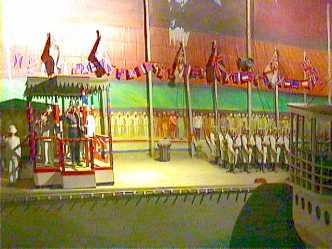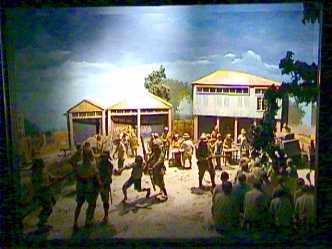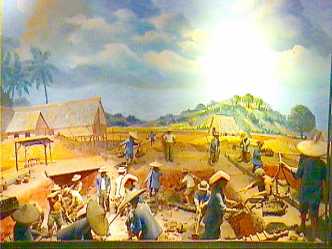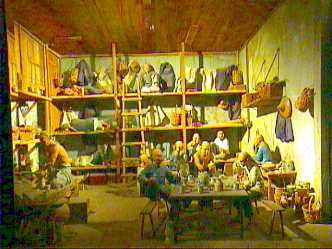|
|
 |
History | Things Not To Be Forgotten
|
|
With the help of Raffles, Singapore economy went from strength to strength
throughout the 19th and early 20th century. But this
didn’t last long. The start of World War II was the beginning of the suffering
for the citizens of Singapore.
The British built a naval base in the north of Singapore. On top of that, they
built underground bunkers in secret places all over the island. These bunkers
were used as stores and also acted as air raid shelter. Their plan of defending
Singapore was to prevent an attack from the sea. Big guns were placed in
Singapore to fire at big ships. These guns could also fire enemies on the land
but they were not equipped with the proper ammunition for these type of targets.
 The British, who had prepared for an invasion from the seas in the south, were
taken by surprise by the Japanese who they travelled within the jungles of
Thailand and Malaysia by bicycle. They did not realized that the Japanese would
travel from the jungles as the jungles were difficult territory for the enemies
to move in. The Japanese were well-trained in jungle warfare so it was a easy
task for them.
The British, who had prepared for an invasion from the seas in the south, were
taken by surprise by the Japanese who they travelled within the jungles of
Thailand and Malaysia by bicycle. They did not realized that the Japanese would
travel from the jungles as the jungles were difficult territory for the enemies
to move in. The Japanese were well-trained in jungle warfare so it was a easy
task for them.
While the Japanese were invading Malaya, they dropped bombs on Singapore. The
British fighter planes were outnumbered by the Japanese "Zero" fighters and
their planes were migrated to Sumatra. By the 31st of January 1942,
the Japanese were already at Johor Bahru. The only thing that
kept them separated from Singapore was the destroyed Causeway.
The Japanese Commander, General Yamashita, set up his headquarters at the Sultan
of Johor's palace. In order to mislead the British, the Japanese made intense
bombings at Changi and attacked Pulau Ubin on the 7th of February
1942. The British thought that Japanese might be invading Singapore from the
northeast, so they moved their stocks of defence supplies like petrol and
explosives from the northwest to the northeast.
The Japanese easily crossed the Strait since the narrowest point of the Johor
Strait was at the northwest of Singapore. The British did not stationed a lot
of troops there and the Japanese took advantage of the situation by sending
divisions of soldiers across from Johor to Singapore with boats and rafts. The
tanks were also made to float across the Johor Strait. Having
such a large area to defend, the Allied Forces could not stop
the Japanese from invading.
The Japanese repaired the Causeway so that their soldiers and ammunition could be
moved to Singapore. The British Commander, General A.E Percival, planed for
the British soldiers to withdraw to protect the town centre if the situation
was serious. Due to misinterpretation, a number of British soldiers on the
western part of the island withdrew before the Japanese moved into the area. In
the end, the Japanese gained control over Bukit Timah.
 On the 11th of February, the Japanese reached Bukit Timah, a place
where the British stocked up food, ammunition, and vehicle and machine parts.
The north-eastern slope of the hill faced a reservoir which
was the water supply for the
British. Intense fighting took place here. Fighting with weapons that were
used for hunting birds and animals, the Chinese Volunteers fought bravely, along
with the Allied Forces. Many casualties were accounted and the Japanese killed
the Chinese found in the nearby village in seek of revenge for their dead
soldiers.
On the 11th of February, the Japanese reached Bukit Timah, a place
where the British stocked up food, ammunition, and vehicle and machine parts.
The north-eastern slope of the hill faced a reservoir which
was the water supply for the
British. Intense fighting took place here. Fighting with weapons that were
used for hunting birds and animals, the Chinese Volunteers fought bravely, along
with the Allied Forces. Many casualties were accounted and the Japanese killed
the Chinese found in the nearby village in seek of revenge for their dead
soldiers.
The Japanese reached Pasir Panjang Ridge (known as the Kent Ridge Park in the
present day) on the 13th of February. It was near to the Alexandra
area where the British stored most of their ammunition and the location of the
military hospital. The soldiers from the Malay Regiment, led by Lieutenant (Lt.)
Adnan bin Saidi killed many of the Japanese soldiers. The following day, the
Japanese disguised themselves as Indian soldiers in the British army. Lt. Adnan
discovered that some of the soldiers were not marching in the usual threes, and
so he asked his soldiers to shoot at the imposters, killing several of them and
some fled down the hill. The Japanese soon surrounded the hill and the Malays
were outnumbered. Lt Adnan was shot by the enemy and despite of his injuries,
he continued fighting. In the end, he was captured by the Japanese and been
stabbed to death.
Soon after the Japanese arrived at the Alexandra Hospital. The massacre at the
hospital left no survivals. Soon, the day of the Chinese New Year arrived. A
meeting was held at Fort Canning. General Percival had a discussion with other
generals on how to counter-attack. The other generals were against this idea as
their soldiers were tired and their supplies of food and water were depleting.
In the end, the British decided to surrender.
The period when the Japanese controlled Singapore was known as the Japanese
Occupation. The Japanese Occupation lasted for three and a half years and
Singapore was later named, Syonan-to, which means 'Light of the South' in
Japanese. But this light did not shine brightly as this was the dark period
where many people suffered.
 The Japanese imprisoned all the Europeans found in Singapore and they became
the prisoners-of-war (P.O.W.s). The life of the P.O.W.s was tough. Some of them
were sent to Thailand to construct a railroad. They were not given much food to eat and were
made to work long hours. The railroad which was supposed to
take 5 years to complete was forced to be completed in 16 months and this costs
thousands of lives and the railway was known as the Death Railway. The P.O.W.s located
in Singapore did not have a good life either. They were required to clean up the
city, bury the dead bodies and restore water and electricity supplies. The
P.O.W.s had to plant their own vegetables as there was a shortage of food. Due
to the poor health conditions many fell ill and died.
The Japanese imprisoned all the Europeans found in Singapore and they became
the prisoners-of-war (P.O.W.s). The life of the P.O.W.s was tough. Some of them
were sent to Thailand to construct a railroad. They were not given much food to eat and were
made to work long hours. The railroad which was supposed to
take 5 years to complete was forced to be completed in 16 months and this costs
thousands of lives and the railway was known as the Death Railway. The P.O.W.s located
in Singapore did not have a good life either. They were required to clean up the
city, bury the dead bodies and restore water and electricity supplies. The
P.O.W.s had to plant their own vegetables as there was a shortage of food. Due
to the poor health conditions many fell ill and died.
 There was no good life for the local citizens as well. They had to bow to the
Japanese soldiers when they came across them. Those who did not do that were
being punished by the Japanese, either beating them up or killed them. The
Japanese were cruel, so cruel that they could throw babies up to the skies and
stabbed them with
their bayonet while they they are falling. Young man were being taken away to construct the Death Railway in
Thailand. Some of the Malays and Indians were also sent to construct the Death
Railway. The Japanese wanted the Indians to join the Indian National Army
(I.N.A) to fight against the British in India. But many of them refused and were
being killed on the spot. The Eurasians who were suspected of helping the
British were being shot.
There was no good life for the local citizens as well. They had to bow to the
Japanese soldiers when they came across them. Those who did not do that were
being punished by the Japanese, either beating them up or killed them. The
Japanese were cruel, so cruel that they could throw babies up to the skies and
stabbed them with
their bayonet while they they are falling. Young man were being taken away to construct the Death Railway in
Thailand. Some of the Malays and Indians were also sent to construct the Death
Railway. The Japanese wanted the Indians to join the Indian National Army
(I.N.A) to fight against the British in India. But many of them refused and were
being killed on the spot. The Eurasians who were suspected of helping the
British were being shot.
The Chinese suffered the most in this period of time. The Japanese told all the
Chinese males aged between 18 to 50 to report at certain centres. They were
being "examined" by traitors (known as "han jian" in Chinese), who wore hoods or
masks to prevent people from identifying them. These traitors would point out
whether the Chinese were anti-Japanese. Those who were identified as
anti-Japanese were detained and those who were not were stamped with the word
"Examined" which acted like a pass. Some of the Chinese who were known to be
anti-Japanese were sent to beaches where they got shot by the Japanese. The rest
were sent to the Japanese Military Police, known as Kempeitai, where they were
tortured and beaten up to reveal information the Japanese
wanted. It was also the Kempeitai who caused dispute among the
people. They had spies everywhere who would supply them with
information of people who are unhappy with the Japanese rule.
It was a time when everybody did not know who to trust.
To satisfy the sexual lust of the Japanese Military as well,
many local women and girls as young as 6 to 7 years old were
caught and sent to comfort houses where they would serve as
comfort women. Each day they have to serve as much as 40 to 50
Japanese soldiers. Those who could not satisfy them or made
them happy were killed by shooting in their private parts.
Many women committed suicide because they could not withstand
the horror and shame they were going through.
The Japanese set up schools to teach people the Japanese language and every
morning, the people had to face the direction of Japan and sing the Japanese
National Anthem. The food was being controlled by the Japanese. The locals were
given ration cards which limited the amount of food for each person. The money
that the Japanese issued made the situation worse. The notes were known as
"banana notes", printed with pictured of banana and other fruit trees. The note was
printed on bad quality paper and had no serial number on it. When the
authorities needed money, they just have to print the notes. As a result, the
value of the banana notes dropped to the extent that it became
worthless paper.. Derived from this banana notes, the phrase
"banana money" means useless money. People could be seen going
shopping carrying bags of banana notes. I used towel could
cost as much as $300 worth of banana notes.
Soon an anti-Japanese group called the Malayan People's Anti-Japanese Army
(M.P.A.J.A.) was formed. This group attacked the Japanese officers and their men
when the opportunity comes. Another group called Force 136 was formed by a
secret British organisation. This group gathered information about the Japanese.
Some of the locals were recruited into the group and were trained in India. They
will then be secretly sent into Malaya by submarine to assist M.P.A.J.A. against
the Japanese. Lim Bo Seng, a Singapore businessman, led the Force 136 but he was
captured by the Japanese in March 1944. He was being tortured to reveal the
names of those who were in the group but he did not. In the end, he died in
prison in June 1944. Finally, the Japanese surrendered on the 14th of
August 1945 after the bombing of Hiroshima and Nagasaki by the Allied forces led
by the Americans.
This part of the history taught us a lesson. We should be well-prepared to
defend the country against any enemy and not wait for people to save us.
Know more of Raffles
|
A new life
|
|
|
|
|